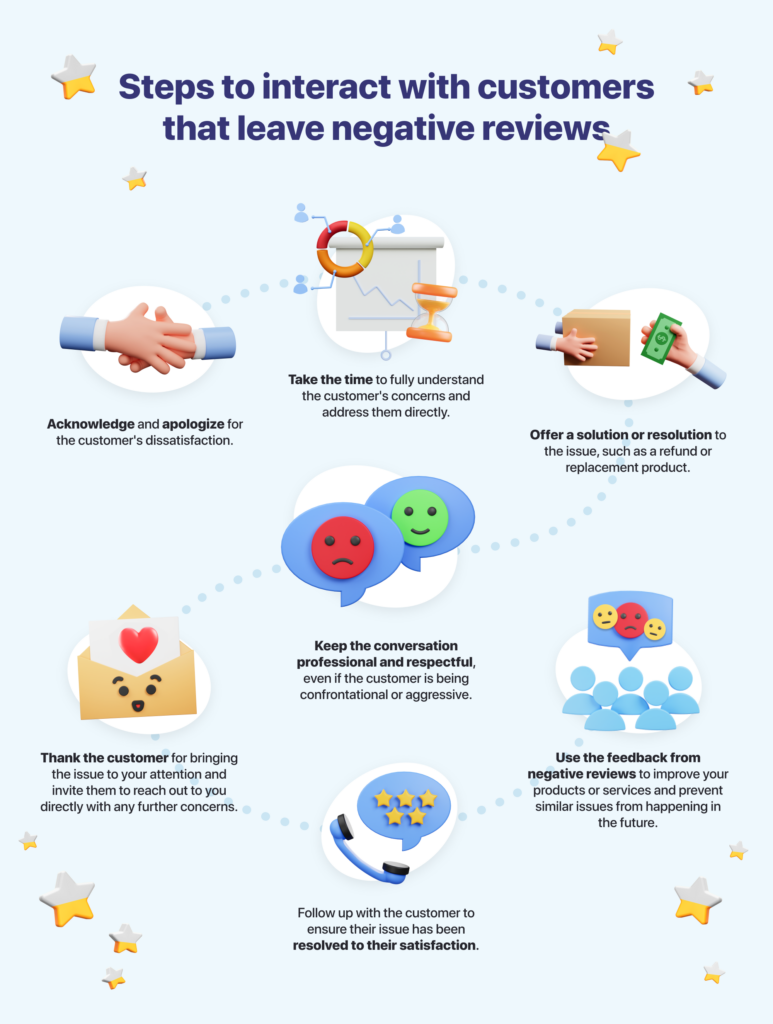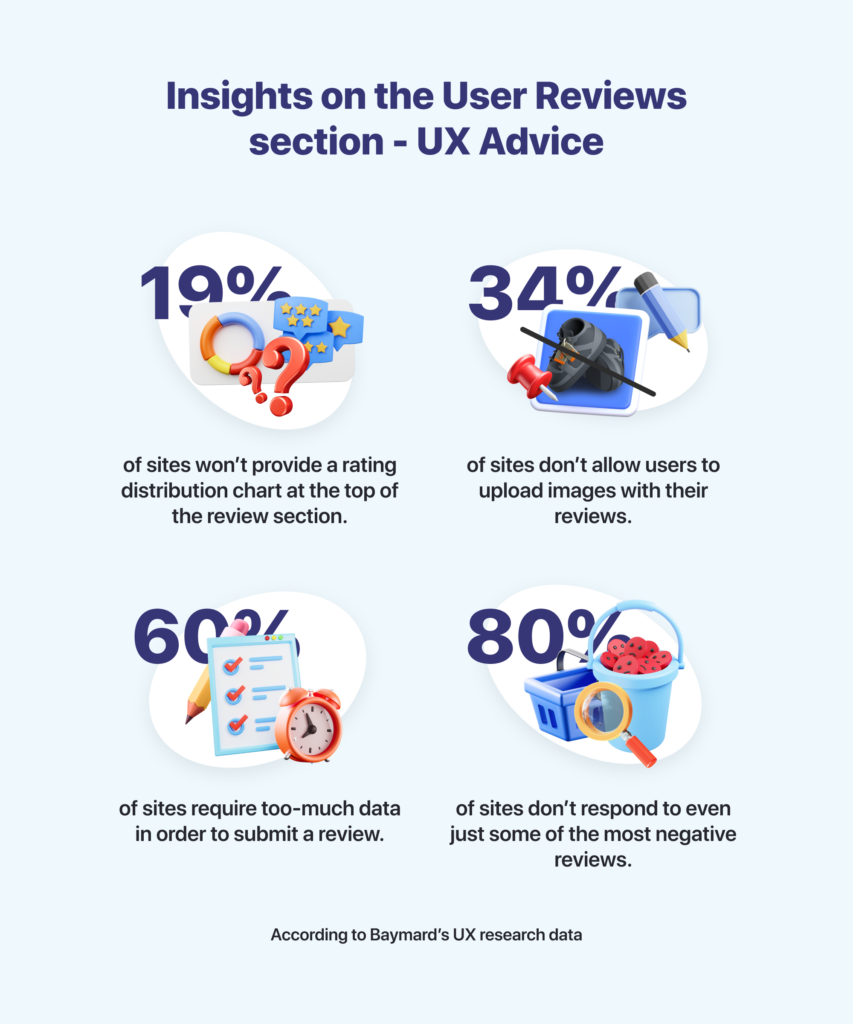It is difficult to determine the exact number of people who leave negative reviews as it depends on various factors, such as the type of product or service being reviewed, the overall satisfaction of the customer, and the platform on which the review is being left.
However, according to a study by BrightLocal, 63% of consumers are more likely to leave a review if they have had a negative experience.
It gets better though:
It’s okay to receive negative feedback.
The shoppers expect to see negative reviews because:
- They want to know the full range of experiences that other customers have had with the product or service.
- They want to see the pros and cons and make an informed decision on whether to purchase the product or not.
- They believe that no product or service is perfect, and it is unrealistic to expect only positive reviews.
- They expect transparency and honesty from the company, which can build trust and credibility.
This article has been designed to become the ultimate stop for eCommerce merchants who collect testimonials and customer feedback. The article will focus on the following:
✔️ 21 online statistics on negative reviews (2023)
✔️ Negative review examples
✔️ How negative reviews affect your business
✔️How to deal with and respond to negative reviews
✔️ 15 response templates for bad reviews and false testimonials
With all that said, this begs the question:
Table of Contents
- What are negative reviews?
- How do negative reviews impact a business?
- 21 Negative review statistics for 2023
- Negative Review Examples
- How to respond to bad reviews
- Templates to answer bad product reviews
- Best way to respond to negative reviews that are not true
- How do companies remove negative reviews
- How do you avoid bad product reviews?
- FAQ: Negative reviews and how should your business deal with negative reviews
- Why are negative reviews good?
- Why is it important to respond to negative reviews?
- What should marketing managers do if their company receives negative reviews?
- Do negative reviews affect business?
- Should companies respond to negative reviews?
- Do people only leave negative reviews?
- How do you respond to a negative person?
- Why are there more negative reviews than positive ones?
- What do bad reviews do to a business?
- Why do people leave nasty reviews?
What are negative reviews?
Negative reviews are critical and unfavorable evaluations or assessments of a product, service, or experience.
Such feedback often highlights flaws, shortcomings, or dissatisfaction with the quality or performance of the subject being reviewed.
Negative reviews can be damaging to a business or brand’s reputation and can discourage potential customers from using their products or services.
Nonetheless, are poor reviews only bad for a business?

How do negative reviews impact a business?
Receiving a bad review can be devastating. It’s natural to feel frustrated and upset, especially if the review is unfair or unjustified.
But it’s important to remember that not all bad reviews are bad news. How can companies benefit from negative reviews?
Dealing with poor reviews helps:
Collect valuable feedback
By responding to negative reviews, businesses have the opportunity to address any issues and improve their services.
Demonstrate your business’s attitude
Responding to negative reviews shows unhappy customers that the business cares about their satisfaction and is willing to take action to improve.
Maintain the brand’s reputation
Responding to negative reviews can help maintain the business’s reputation. Ignoring negative reviews can make the business appear unprofessional and uncaring.
Deal with false accusations
Responding to negative reviews can prevent the spread of misinformation. By addressing any false claims in a negative review, businesses can ensure that accurate information is being shared about their services.
Maintain trust and credibility
Responding to negative reviews can help maintain trust and credibility with customers. By showing that the business takes customer feedback seriously and is willing to make changes based on it, customers are more likely to trust and continue doing business with the company.
Stay away from possible legal issues
Responding to negative reviews can help businesses stay ahead of potential legal issues. By addressing negative reviews promptly and taking appropriate action, businesses can avoid potential legal issues and maintain a good reputation.
Retain the customers
Responding to negative reviews can help businesses retain customers. By showing that the business is willing to make changes and improve based on customer feedback, customers are more likely to remain loyal to the business.
Attract new customers
Responding to negative reviews can help businesses attract new customers. By showing that the business is responsive and willing to address customer concerns, potential customers are more likely to consider doing business with the company.
Improve customer experience
Responding to negative reviews can help businesses improve their services and the overall customer experience in the long run. By listening to and addressing customer feedback, businesses can make necessary improvements and provide a better experience for all customers.
21 Negative review statistics for 2023
Now that you know what role negative comments play for a business, let’s turn to data gathered by the leading research companies to support the idea of negative testimonials being crucial for business owners.
- A study found that 90% of respondents said that positive reviews influenced their purchasing decisions, while 86% said that negative reviews did the same (Source: Dimensional Research).
- A study by Spiegel Research Center found that for every one-star increase in rating, there is a 5-9% increase in revenue.
- According to a survey by Reputation Management Consultants, 77% of consumers will not purchase from a business with a rating below three stars.

4. A study by Search Engine Land found that 67% of consumers have been influenced by a negative review while shopping.
5. A study by BrightLocal found that 49% of consumers need at least a 4-star rating before they consider using a business.
6. A study by Dimensional Research found that 95% of consumers have used online reviews to decide whether or not to purchase a product or service.
7. A study by Spiegel Research Center found that the average conversion rate for businesses with a rating of 4.2 stars or higher is 10.6%, while the average conversion rate for businesses with a rating of 3.0 stars or lower is 2.6%.
8. A survey by Reputation Management Consultants found that 70% of consumers will read up to 10 reviews before forming an opinion about a business.
9. According to a survey by Podium, 63% of consumers are more likely to make a purchase from a business with positive reviews.
10. A study by ReviewTrackers found that businesses with a rating of 4 stars or higher on average had a 22.2% higher conversion rate than those with a rating of 3 stars or lower.
11. A survey by Trustpilot found that 90% of consumers consider online reviews to be as important as personal recommendations.
12. A survey by McKinsey found that businesses with a rating of 4 stars or higher on average had a 19% higher click-through rate on their website than those with a rating of 3 stars or lower.
13. A survey by Gartner found that only 14% of businesses respond to negative reviews, despite the fact that 88% of consumers read them.

14. A study by BrightLocal found that negative reviews can lead to a loss of 22% of customers.

15. A study by Trustpilot found that 87% of consumers will read up to 10 reviews before forming an opinion about a business.
16. 94% of consumers say that an online review has convinced them to avoid a business (BrightLocal).

17. More than half of consumers will leave a review after a negative experience (Zendesk).
18. Responding to negative reviews can increase customer trust by as much as 25% (BrightLocal).

19. 59% of consumers say that the response to a negative review is more important than the review itself (BrightLocal).
20. 52% of consumers say that a business with no reviews is less trustworthy than a business with both positive and negative reviews (BrightLocal).
21. One negative review can cost a business up to 30 customers (Reputation Defender).

Negative Review Examples
If you are just starting your eCommerce business, poor reviews can be frustrating, discouraging and damaging for a young compny.
Here’re some bad review examples to demonstrate what insights negative feedback can contain and help you tune in for success:
Example #1:
Source: Tripadvisor
Example #2:
Source: Yelp
Example #3:
Source: Booking.com
Example #4:
Source: Dealer Rater
Example #5:
Source: Skytrax
Example #6:
Source: Trustpilot
How to respond to bad reviews
Here’s the deal:
Bad reviews are inevitable, especially in today’s digital world where consumers have high standards and a host of platforms where they can share their experiences and opinions online that include but are not limited to:
- Online product or service review websites such as Yelp, Trustpilot, and Consumer Reports.
- Social media platforms such as Facebook, Twitter, and Instagram where customers can leave reviews or comments on a business or product.
- Online forums or discussion boards where customers can share their experiences and feedback about a particular product or service.
- Google search results where customers can leave reviews on a business’s Google My Business page.
- Online marketplaces such as Amazon, eBay, and Etsy where customers can leave ratings and reviews on the products they have purchased.
While it can be frustrating to receive negative feedback, it’s important to remember that responding to bad reviews has its benefits an can even turn the situation around.
Take a look at the infographics below for clear-cut instructions on how to deal with negative company reviews (and negative reviews in general):

In other words, to transform a negative experience into a good one and gain back customer trust, you should:
- Take a deep breath and try not to take it personally. It’s natural to feel hurt or upset when someone leaves a negative review, but it’s important to remain professional and not let emotions cloud your judgment.
- Respond promptly and politely. Acknowledge the customer’s concerns and apologize for any inconvenience or dissatisfaction they may have experienced. Offer to make things right by providing a refund or exchange, if appropriate.
- Take the conversation offline. If the customer has left contact information, reach out to them privately to discuss their concerns and find a resolution. This allows for a more personalized and discreet conversation, which can help diffuse the situation and prevent further negative online reviews.
- Investigate the issue and take action. If the customer’s concerns are valid, it’s important to take action to prevent similar issues from occurring in the future. This could involve implementing new procedures, retraining staff, or even recalling the product if necessary.
- Monitor and manage your online reputation. Regularly check your online reviews and respond to both positive and negative feedback in a timely manner. This shows customers that you value their feedback and are willing to address any issues that may arise.
- Use negative feedback as an opportunity to improve. While it’s natural to want to avoid bad reviews, they can actually provide valuable insights into how your business can improve. Use negative feedback as an opportunity to learn and make necessary changes to enhance the customer experience.

Templates to answer bad product reviews
While it can be tempting to simply remove negative business reviews or respond with anger, to grow your business, it’s important to handle the situation professionally.
One way to do this is by using templates to craft perfect responses to bad product reviews. By having a set bad review response ready, you can quickly and efficiently address the issue without getting caught off guard or resorting to an emotional response.
While you are welcome to customize the templates we share below by adding a contact phone number or other contact information, these response ideas to negative business reviews will certainly help you get started.
How to reply to bad reviews?
Template #1
Hello {Customer Name},
Thank you for taking the time to leave a review, and we apologize for any inconvenience you experienced.
We take all feedback seriously and will work to improve in the areas you mentioned.
Best regards,
{Employee at Company Name}
Template #2
Hello {Customer Name},
We appreciate your feedback and apologize for any shortcomings in your experience. Please don’t hesitate to reach out to us directly so we can address your concerns and make it right.
Kindly,
{Сompany Name}
Template #3
Hello {Ccustomer Name},
Thank you for bringing this to our attention. We apologize for the inconvenience and will take steps to ensure this doesn’t happen again in the future.
Best regards,
{Employee at Company Name}
Template #4
Dear {Customer Name},
We are sorry to hear that your experience was not up to par.
Please accept our sincere apologies and let us know how we can make it up to you.
Best regards,
{Employee at Company Name}
Template #5
Dear {Customer Name},
Thank you for sharing your feedback. We are constantly working to improve and your input is valuable to us. We apologize for any missteps and will use your feedback to improve in the future.
Yours truly,
{Сompany Name}
Template #6
Hello {Customer Name},
We apologize for any negative experience you had with our product/service. Your satisfaction is important to us, and we will do everything in our power to rectify the situation.
Yours truly,
{Сompany Name}
Template #7
Hi {Customer Name},
Thank you for your review, and we are sorry to hear that you were not satisfied with our product/service.
We value your business and would like the opportunity to make it right. Please contact us directly at your_email_address so we can resolve any issues.
Kindly,
{Сompany Name}
Template #8
Dear {Customer Name},
We apologize for the poor experience you had with our product/service.
We take all feedback seriously and will work to improve in the areas you mentioned. Thank you for bringing this to our attention.
Best regards,
{Сompany Name}
Template #9
Hello {Customer Name},
Thank you for sharing your thoughts. We apologize for any dissatisfaction and will take steps to ensure this doesn’t happen again in the future.
Your feedback is important to us, and we value your business.
Kindly,
{Сompany Name}
Template #10
Hello {Customer Name},
We are sorry to hear that your experience was not up to your expectations.
Please accept our sincere apologies and let us know how we can make it right. We value your business and appreciate your feedback.
Kindly,
{Сompany Name}
Best way to respond to negative reviews that are not true
If a review is not true, responding to online reviews politely is best for your brand image, no matter what.
Acknowledge the review and thank the customer for their feedback, but also provide factual information to refute any false statements.
It is important to remain calm and avoid becoming defensive or argumentative. It may be helpful to offer to address any issues or concerns the customer may have directly, and to invite them to contact the business for further assistance.
Here are five negative review response templates to help you deal with fake or false feedback:
Template #1:
Hello {Customer Name},
Thank you for bringing this issue to our attention. We apologize for any inconvenience you may have experienced and would like to address your concerns.
However, we have reviewed our records and do not see any evidence of the issue you have described.
If you could provide more specific details, we would be happy to investigate further and assist you in any way possible.
Best regards,
{Сompany Name}
Template #2:
Hello {Customer Name},
We apologize if your experience with our company was not up to your expectations.
However, we take all customer feedback seriously and would like to address the issues you have raised.
After reviewing your review, we have found that the issues you described are not accurate and do not reflect our policies or practices.
We would be happy to discuss this further with you and find a resolution.
Best regards,
{Сompany Name}
Template #3:
Hi {Customer Name},
Thank you for taking the time to leave a review. We value all customer feedback, both positive and negative, and take it seriously.
However, we are disappointed to hear that your experience with our company was not what you had hoped for.
After reviewing your review, we have found that the issues you described are not true and do not reflect our commitment to customer satisfaction. We would be happy to discuss this further and make things right.
Best regards,
{Сompany Name}
Template #4:
Hello {Customer Name},
We appreciate your feedback, but we believe that this review is not accurate. Our records show that the issue you describe did not occur at our business.
Could you please share more details so that we could investigate?
Best regards,
{Сompany Name}
Template #5:
Dear {Customer Name},
Thank you for your review, but we have checked our records, and it appears that the incident you described did not happen at our establishment. We take all feedback seriously and would like to address any concerns you may have, but we cannot address something that did not occur.
Best regards,
{Сompany Name}
How do companies remove negative reviews
Let’s accept it:
Negative reviews can be damaging to a company’s reputation and can even lead to lost business. Therefore, it is important for companies to address and remove negative reviews when required.
Here’s what you can do to deal with bad feedback:
- Respond to a negative review and address the customer’s concerns: This can sometimes result in the customer modifying or removing the review themselves.
- Contact the review platform and request that the review is removed: Many review platforms have policies in place for removing reviews that violate their guidelines, such as those that contain profanity or personal attacks.
- Offer compensation or incentives to the customer: In some cases, companies may offer a discount, free product, or other incentives to the customer in exchange for removing the negative review.
- Use reputation management services: These services can help companies monitor and manage their online reputation, including identifying and removing negative testimonials.
- File a legal complaint: In extreme cases, companies may consider filing a legal complaint against the person who posted the negative review, claiming defamation or other grounds for removal.
How do you avoid bad product reviews?
To avoid negative feedback, you should focus on providing high-quality products and services, ensuring customer satisfaction, and addressing any complaints or concerns promptly and efficiently.
This can be achieved through implementing effective customer service strategies, regularly soliciting feedback from customers, and consistently meeting or exceeding customer expectations.
Besides, consider encouraging satisfied customers with review incentives to leave positive reviews to counteract any negative ones.
💡 Need to advance the product reviews functionality in your Shopify-based store? Click here to learn more about the free application by Webtex.

FAQ: Negative reviews and how should your business deal with negative reviews
Why are negative reviews good?
Why is it important to respond to negative reviews?
This can help to improve the customer’s overall satisfaction and can potentially prevent the customer from spreading negative feedback to others.
Additionally, responding to negative reviews can show potential customers that the business takes customer feedback seriously and is willing to make changes based on that feedback. This can help to build trust and credibility with potential customers and can potentially lead to increased sales and positive reviews.
What should marketing managers do if their company receives negative reviews?
- Address the issue promptly and professionally. Acknowledge the customer’s experience and apologize for any inconvenience or dissatisfaction.
- Take ownership of the situation and offer a solution. This may involve offering a refund or discount or providing additional support or service to resolve the issue.
- Monitor and respond to all negative reviews, both on the company’s website and on external review platforms.
- Use the feedback as an opportunity to improve the negative experiences and prevent similar issues from happening in the future.
- Consider implementing a customer feedback and review management system to monitor and respond to negative reviews more efficiently.
- Monitor and track trends in negative feedback and use this information to identify and address any underlying issues or weaknesses in the company’s products or services.
- Communicate openly and transparently with customers about the steps the company is taking to address negative reviews and improve the customer experience.
Do negative reviews affect business?
Additionally, negative reviews can discourage new customers from trying the business and can even lead to the loss of existing customers. Overall, bad testimonials can have a significant negative impact on a business.
Should companies respond to negative reviews?
Also, responding to negative reviews can help improve the company’s reputation and build trust with customers.
Do people only leave negative reviews?
How do you respond to a negative person?
Why are there more negative reviews than positive ones?
- People are more likely to leave a review when they have had a negative experience than when they have had a positive experience. This is because people are more likely to be motivated to leave a review when they are unhappy or dissatisfied with a product or service.
- People are more likely to share their negative experiences with others, and reviews are a way to do that. When someone has had a negative experience, they may want to warn others about it so that they don’t have the same experience.
- Negative reviews are more attention-grabbing than positive ones. People are more likely to read a negative review because it is more likely to be interesting or surprising.
- Companies are more likely to respond to negative reviews than positive ones. This may be because they want to try to fix the problem or make the customer happy, but it also means that negative reviews are more likely to get a response from the company, which may make them more visible.
- Some people may be more critical or picky than others, and are therefore more likely to leave negative reviews. These people may be more likely to notice problems or issues with a product or service, and are more likely to leave a negative review because of that.
What do bad reviews do to a business?
Why do people leave nasty reviews?
- They had a negative experience with the product or service and want to warn others.
- They are angry or frustrated and want to vent their emotions.
- They want to get back at the company or individual for something they perceive as unfair or dishonest.
- They are trying to damage the reputation of the company or individual in order to gain an advantage or benefit for themselves or someone else.
- They have a personal vendetta against the company or individual and want to cause harm or distress.
- They are malicious or have a grudge and want to hurt the company or individual for no apparent reason.

